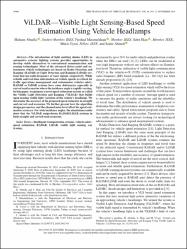ViLDAR-Visible light sensing-based speed estimation using vehicle headlamps
Citation
Abuella, H., Miramirkhani, F., Ekin, S., Uysal, M., & Ahmed, S. (2019). ViLDAR-visible light sensing-based speed estimation using vehicle headlamps. IEEE Transactions on Vehicular Technology, 68(11), 10406-10417. doi:10.1109/TVT.2019.2941705Abstract
The introduction of light emitting diodes (LED) in automotive exterior lighting systems provides opportunities to develop viable alternatives to conventional communication and sensing technologies. Most of the advanced driver-assist and autonomous vehicle technologies are based on Radio Detection and Ranging (RADAR) or Light Detection and Ranging (LiDAR) systems that use radio frequency or laser signals, respectively. While reliable and real-time information on vehicle speeds is critical for traffic operations management and autonomous vehicles safety, RADAR or LiDAR systems have some deficiencies especially in curved road scenarios where the incidence angle is rapidly varying. In this paper, we propose a novel speed estimation system so-called the Visible Light Detection and Ranging (ViLDAR) that builds upon sensing visible light variation of the vehicle's headlamp. We determine the accuracy of the proposed speed estimator in straight and curved road scenarios. We further present how the algorithm design parameters and the channel noise level affect the speed estimation accuracy. For wide incidence angles, the simulation results show that the ViLDAR outperforms RADAR/LiDAR systems in both straight and curved road scenarios.
Source
IEEE Transactions on Vehicular TechnologyVolume
68Issue
11The following license files are associated with this item:
Related items
Showing items related by title, author, creator and subject.
-
Least minimum symbol error rate based post-distortion for adaptive mobile VLC transmission with receiver selection
Miramirkhani, Farshad; Karbalayghareh, Mehdi; Mitra, Rangeet (Elsevier B.V., 2021-08)In the context of beyond-5G indoor communication systems, visible light communication (VLC) has emerged as a viable supplement for existing RF-based systems and as an enabler for high datarate communications. However, the ... -
A path loss model for link budget analysis of indoor visible light communications
Miramirkhani, Farshad (Istanbul Univ-Cerrahpasa, 2021-05)In the context of beyond 5G indoor communication systems, visible light communications (VLC) has emerged as a viable supplement for existing radio frequency based systems and as an enabler for high data rate communications. ... -
Channel modelling for indoor visible light communications
Miramirkhani, Farshad; Uysal, Murat (Royal Society Publishing, 2020-04-17)Visible light communication (VLC) allows the dual use of light-emitting diodes (LEDs) for wireless communication purposes in addition to their primary purpose of illumination. As in any other communication system, realistic ...


















